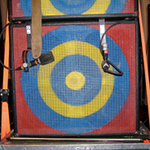David Hartt
David Hartt: Stray Light
Studio Museum in Harlem
144 West 125th Street, New York, NY
March 28–June 30, 2013
For a 2008 series of photographs, the Chicago artist David Hartt (b. 1967) entered the Mackinac Center for Public Policy, a think tank based in Midland, Michigan, to document the offices of a group that favors free markets, lower taxes, reduced regulation, and economic privatization. Hartt’s recent project, Stray Light, ricochets to the opposite end of the political spectrum, offering a similar glimpse into the headquarters of the Johnson Publishing Company (JPC), which created Ebony and Jet magazines, among others. The exhibition at the Studio Museum in Harlem comprised seven color photographs and a room-sized installation housing a twelve-minute video, a two-piece aluminum and Plexiglas sculpture, a Knoll bench, and patterned carpet.
Founded in Chicago in 1942 by the Arkansas-born entrepreneur John H. Johnson (1918–2005), JPC found great success in publishing, which led to the construction of an eleven-story building at 820 South Michigan Avenue, completed in 1972, to house his growing media empire. Although the edifice, conceived by John W. Moutoussamy, was the first major modern work by an African American architect in the Loop, the majority of Stray Light focuses on the interiors, designed by the Californian firm William Raiser/Arthur Elrod, whose color schemes of orange, salmon, peach, ochre, mustard, khaki, and caramel have remained largely unchanged.
The photographs demonstrate a high level of aesthetics. In Archive (all works 2011), the oblique angle of a long, striped ledge fills the picture’s bottom half, under an expanse of wall, ceiling tiles, and fluorescent lights. Banker’s boxes and magazine files peek over the countertop, on which rests a short African sculpture from the company collection of modern and tribal art. A sense of pride is felt in Award Room, which boasts framed black-and-white pictures of Johnson with presidents John F. Kennedy and Lyndon B. Johnson and plaques resting on a table. The presence of Johnson’s wife and business partner, Eunice Walker Johnson (1916–2010), is detected in Kiosk, a glass-enclosed beauty salon lined with peacock-patterned wallpaper on the floor devoted to Fashion Fair Cosmetics, a makeup line she founded.
The exhibition’s video is a collection of images from a stationary camera, occasionally showing people at their computers or in meetings but mostly lingering over empty offices, common spaces, and corridors. One sequence takes place in a library, with close-ups of clothbound books of classic African American literature and bound JPC periodicals whose hardcovers match their subject: Tan is tan, Jet is black, Hue is green. Another sequence gives a behind-the-scenes look at Eunice’s fashion collection, with conditioned air blowing on showroom racks of haute couture. The video’s melodic yet spontaneous jazz soundtrack, composed by Nicole Mitchell, jumps and dawdles along with the onscreen images.
Hartt rarely permits scenes with vistas overlooking Grant Park and Lake Michigan and avoids depicting the building’s signature façade. In fact, he only references the structure—a post-and-lintel form resembling a ladder—in the sculpture, a flat piece of vermillion-colored aluminum cut to the building’s shape. The installation also includes a wall-to-wall carpet of interlocking hexagons in orange, brown, and tan—the same pattern and colors found on one floor in the JPC building.
Stray Light explores the iconography of the era in which the artist grew up but did not fully experience. Hartt is black but was raised in Montreal by adoptive Jewish parents. He admittedly sees African American history and culture with detachment, which is reflected in the straightforward nature of his photographs and video. In that way, his work finds an affinity with artists such as Carol Bove (b. 1971), who arranges feathers, driftwood, and vintage 1960s and 1970s paperbacks on shelves, or Hank Willis Thomas (b. 1976), who exhibits photographs of decades-old magazine advertisements—many taken from JPC publications—with the text removed. Bove excavates the aspirations of a progressive era; Thomas probes lifestyle myths endorsed through the black models’ hairstyles, clothing, and accessories.
Though strongly resonating as a memorial, Hartt’s project mitigates nostalgia by engaging the present moment and a specific subject: the effect of technology on business and architecture. “Over time, the needs required of a building often drift from the original ideological purpose,” he told the Chicago Reader last year. “My work can be read as intimate portraits of dreams and ideals that have not failed as much as been subtly displaced or altered.” Like many twenty-first-century publishers, JPC has suffered significantly in recent years. After selling the building in 2012 to Columbia College Chicago, the company now rents three floors elsewhere on South Michigan Avenue. The school plans to transform the building into a library and archive. It will house the school’s Center for Black Music Research while preserving many architectural features, not unlike Hartt’s tribute in Stray Light.
